Guild Wars 2 preview

I'd only got up to take a phonecall. Getting back to my seat to continue levelling my Guild Wars 2 character, I found it occupied by a cheerful American in an NCsoft T-shirt. You're not me, cheerful American, I'm me! Who are you?
He was one of the dev team, and he'd spent the last few years coding this game. He should see it as numbers and rules. But there he was, grinning and gesticulating with my fellow journalists at this Hamburg press event as they battled through a dungeon, not five minutes after I left my chair.
“We're trying to combat the barriers to having a cooperative experience together,” Eric Flannum tells me. He's Guild Wars 2's lead designer, and clad in the same white and red Guild Wars 2 T-shirt as my seat usurper. Prior to my interview, he was sitting on a spare seat, leaning over the shoulder of a colleague and dispensing tanking advice in staccato bursts. He seemed to be having such a good time, I felt bad taking him away from the group. But as he started to talk, his eyes lit up.
“We're bringing a cooperative experience that's a bit different to other MMOs. This isn't a systemic thing, it isn't 'feature A': it's everything in the game coming together to make it feel very cooperative.” Central to this pervading co-oppiness are Guild Wars 2's dynamic events: nearby players forming ad-hoc gangs to take down large enemies, without needing to join a formal group.
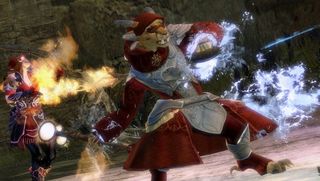
Eric knows this inclusive method makes his game different to its MMO peers. “Say another group is on your quest and got to the marker before you. They need to kill their set of things, and you need to kill your set of things: it means you can't adventure in the same area. So you leave because that MMO etiquette has developed: 'we're here first'.” But in Guild Wars 2, the sight of fellow players on the horizon isn't a prelude to a gank: it's potential salvation.
I had a shark attached to my leg the first time I was saved. I'd been floating ten feet under the surface of the water in a bay when it happened. I'd only gone for a swim.
Guild Wars 2's underwater combat is peculiarly responsive. Venturing below the waves in games is usually an exercise in mouse-slamming frustration; here, it's like flying. My character moved quickly and turned on the spot, a rebreather clamped to his face meant I didn't have to worry about oxygen supply – even the weapon-set changed, switching my Engineer's blunderbuss for a harpoon and net combo. Given that much freedom, I was confident in my combat ability. Too confident.
The biggest gaming news, reviews and hardware deals
Keep up to date with the most important stories and the best deals, as picked by the PC Gamer team.
In an orgy of fish-murder, I'd unwittingly got close to the wreck of a pirate ship. Like most of Guild Wars 2, it was beautiful: dappled wood and burnished metal, illuminated by shimmering blue light. I cooed, turning my attention away from the seven foot-tube of teeth bearing down on me. I whirled around in the water, milliseconds before the teeth clamped around my extremities.
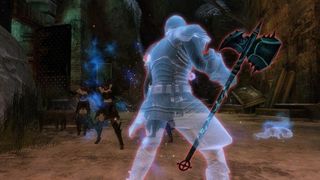
The Engineer is built to be played from a distance. He's got a huge range of toys at his disposal. His standard firearms pack a mighty punch, and he can use special kits to dramatically alter his role on the battlefield. The flamethrower kit is handy for cordoning off segments of the battlefield, while his grenade kit gives him devastating crowd control potential. But he's not ideal in for a fistfight. Especially not a fistfight with a shark.
As the shark chewed, metal bolts started to fizz through the water beside me. It became apparent the pirate ship was still a nest for its former residents: I was being bombarded by pirates, who took offence to my proximity to their booty recovery efforts. Down to a third of my health bar and stranded alone, underwater, I contemplated my death.
And then, on the watery horizon: four strangers. They arced through the water toward me, and burst the shark nibbling on my leg like a fishy bag. They quickly moved on to the pirates, giving me time to surface, cast a healing spell on myself, then duck back underwater to help finish off my erstwhile attackers.
Eric quantifies my experience in our interview. “When you choose to play by yourself, you're still playing an MMO. There's a reason you're playing an MMO: because you want to play with other players. But you don't have to join a group, and you don't have to feel you're excluded from content.” But grouping isn't an entirely amorphous process – you're still going to need to band together to hit one of the game's dungeons.
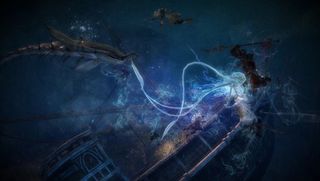
Dungeons, as in other MMOs, provide late-game fun for powerlevellers. But Eric doesn't want to restrict them – and the bulging sacks of loot they contain – to the top end. “We wanted to avoid the feeling that the game doesn't start until max level, and that the game that you played to get to max level is an appreciably different game than when you are at max level.” As such, dungeons are open from level 35, and the eight the game ships with can be played in two modes. 'Explorable' mode is for elite groups, people who've already mastered team fights and can take down the big boys. 'Story' mode is comparatively simpler, and comes with the weight of a plotline. It was this mode we played when our red and white T-shirted overlords took us below ground.
Underneath the city of Ascalon is a maze of catacombs. They'd be a nice place for some caving, were they not infested with vengeful ghosts. Ascalon itself was once Charr land (Guild Wars 2's race of giant fluffy cat-men). In the game's fiction, they were pushed out by humans, only to fight back some 200 years before the current game starts. The catacombs became the final resting place for stubborn human king Adelbern, who refused to surrender his land to the Charr – even when they threatened to moult all over his best jeans.
I joined a small group. Together we were four journalists and one developer, and we sensibly let the seasoned veteran lead the charge. Dungeons played in story mode are designed for pick-up groups: meaning they're balanced for any class combination. Our gang of elementalists, engineers and warriors would have been well-balanced in a traditional MMO in any case, but Eric tells us that this run had been completed earlier in the day by a flouncy gang of thieves.
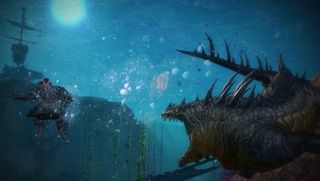
The catacombs' regular ghosts made for hardy enemies, but they fell fast enough to a combined assault. Our de facto leader yelped out targets with rising glee. “HIT THE MONK FIRST! YEAH THE MONK'S DEAD! KILL HIS FRIEND!” Given the softer learning curve afforded by story mode, and the screaming berserker in a white and red T-shirt occupying enemy attention, I was able to wander around the fringes of the battle and roast ghosts with my flamethrower.
While considering the physical improbabilities of using napalm on an ectoplasmic projection, I strayed far from the main group. I was admiring a sparkly cave wall when that wall collapsed in front of me. Through it burst a cave troll: one of the dungeon's dynamic events. “That troll might have appeared somewhere else, or not at all,” relayed our raid leader helpfully as it punched me in the face.
“I don't know if you noticed, but our dynamic events are very visual.” Yes Eric, I did notice, thanks. Your dynamic events are so visual they tried to eat me. “They don't require a lot of explanation. Say you run into a city and there are centaurs attacking everyone: you know what to do, right?” And no, the answer isn't 'try to climb on their backs and ride them around like a horsey.'
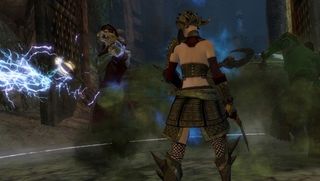
Eric wants the dynamic events to form a pillar of Guild Wars 2's personal story – showing you the heroic quest, not writing it in 14 pages of eight point font. It's an approach closer to singleplayer RPGs than the game's MMO peers.
So too is the game's dedication to player choice. Playing as a low-level Norn (Guild War 2's hardy Viking types), I was struck by the level of character options available to me. My Norn engineer was seven foot of hairy ginger muscle, but when presented with the potential of a brawl at a rowdy fireside boozefest, I smoothly talked him out of trouble. Looking one computer to my right, my neighbour – playing a female Norn engineer two thirds my giant's height – knocked the sucker out. The choices you make change your personal story in physical ways – your home area will alter depending on who you help, a local vendor perhaps moving out of town because you helped the centaurs – but they also tie into a base human desire to actually craft a character.
“I think the biggest problem with current MMOs is that people aren't trying new things,” says Eric. Yet Guild Wars 2 isn't trying anything insanely radical. It is obviously an MMORPG – but it feels like the first of that genre to really understand both concepts in that jumble of letters. Dynamic events and ease of cooperation make the massive gameworld truly multiplayer; a focus on customisation, choice and story make it a true roleplaying game. By going back to the genre's conception, Guild Wars 2 has a real claim to be the MMO of the future.
Most Popular

